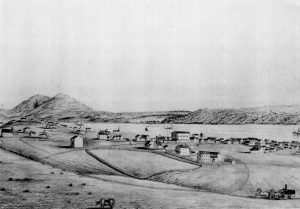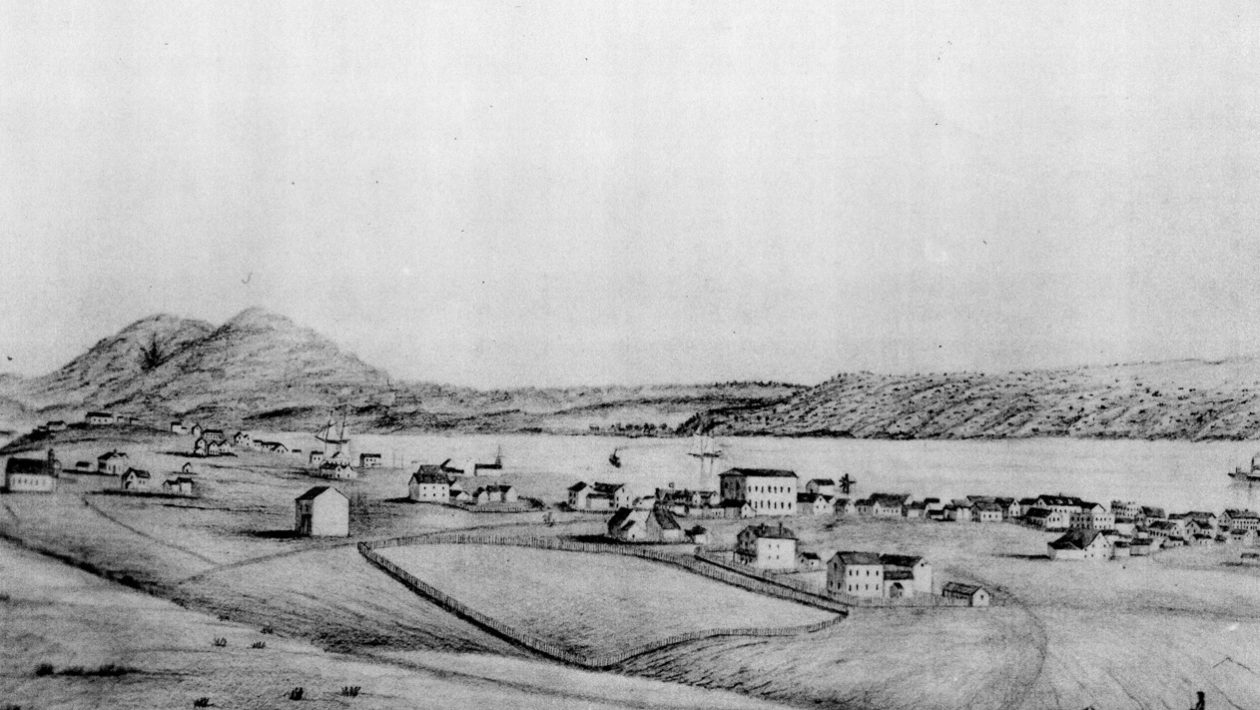By HARRIETT BURT
Martinez News-Gazette Contributor
Editor’s Note: Martinez residents and businesses tend to identify with Contra Costa County in many ways and have especially for the past 6o years since ferry service is no longer needed for us to reach Northern California and beyond. But Benicia is actually Martinez’s “big sister city” as our existence is a direct result of the existence of a ferry to Benicia’s opposite coast (i.e. Contra Costa) two years before gold was discovered in the Sierras.
To make the connection even stronger, Benicia’s founder, Robert Semple, was a Kentuckian who came to California in the 1840s to make a new life at roughly the same time William Smith came here from Georgia and Louisiana for the same reason. Both were restless, ambitious dreamers who saw business and wealth opportunities to make the most of in the Carquinez Strait and Suisun Bay. Both had success followed by failure and both had tragic endings. But both left behind strong communities with long, proud histories.
The late John Bonnell, a rather unsung writer of Martinez history, produced a number of well-researched and interesting articles for the Martinez Historical Society’s newsletter and occasionally for the News-Gazette in the 1980s and 90s. Some were about his boyhood in Martinez and his grandfather, turn of the 19th century local business dynamo J.J. McNamara. McNamara was a partner in the regionally popular Bay View Pavilion, a major part of the restoration of ferry service from Martinez to Benicia in 1914, a merchant, and a builder who died of cancer in the 1920s in the middle of constructing a movie palace, the State Theater, which still stands today as the county’s Public Defender’s office. But Bonnell also wrote about a number of significant town events including the 1904 fire which destroyed two blocks of downtown. We are fortunate that his interests also led him to tell a part of the Martinez story that involves Benicia because if that town had not existed in 1848, Martinez might not have either, at least until much later and it might never have become the county seat. This article was written in 1996 when Benicia was celebrating its 150th anniversary. Also, there is a pun warning regarding Bonnell’s title. (HJB)
A Semple tale of neighbors
By JOHN BONNELL

“Martinez history buffs have a problem. We must acknowledge that Benicia – our closest neighbor, located just over a mile away across Carquinez Strait – has played a more prominent role in both state and national histories than has Martinez. Moreover, Benicia was founded two full years before our own town, and its founder – Dr. Robert Baylor Semple – played an important role in our town’s siting and early development. Martinez and Benicia have always enjoyed common social, civic and commercial interests, and to this day (1996) locals continue to jawbone over what was – or is – the BETTER city.
“As early as 1850 a lady from the east coast, then living with her Quartermaster husband at the (US Army’s) Benicia Arsenal, wrote a friend back home: “Opposite is the little town of Martinez, with hills looking very green and covered with trees. This is the only spot that bears any mark of cultivation. Benicia itself is utterly destitute of trees, or even shrubs. You may ride for miles without seeing a trace of foliage. The hills, however, are very green, which gives the country a fresh appearance. I should speak well of the climate, as it agrees with me, but it is far from agreeable. The winter is, by far, the pleasantest season, notwithstanding the rains. In summer, everything has a parched appearance and the wind blows, without cessation, night and day.”
“From the very beginning, the Sacramento and San Joaquin rivers were ‘the natural highways’ connecting the great, fertile central valleys to the Pacific Ocean. Soon after American settlement began in the early 1840s, visionaries and promoters (like Benicia’s Semple, Martinez’ Col. Smith and Thomas A. Brown), viewed the shoreline of those rivers, along with Suisun and San Pablo bays and Carquinez Strait, as prime sites for great seaport cities that could rival Yerba Buena (San Francisco) for international trade. The great California Gold Rush significantly enhanced and hurried those visions and dreams.
“In December 1845, Kentucky-born dentist Semple arrived in the Bay Area with Lansford Hastings’ overland emigrant party. Nicknamed ‘Oso Bueno’ (good bear), Semple stood six feet seven inches tall in an era when six-footers were a rarity. He was regarded as “generally kindly,” but was also impulsive, headstrong, impatient and unpredictably erratic. Two months before he co-founded California’s first newspaper, “The Californian’, in Monterey in August 1846, Semple was a leader of Sonoma’s Bear Flag Revolt.
“In the aftermath of that short-lived rebellion he began a friendship with Mexican Gen. Mariano Guadalupe Vallejo. In the closing days of 1846 he persuaded Vallejo to sell him five square miles of land along the north shore of Carquinez Strait’ (five miles long and one mile deep). Vallejo owned most of what is today Solano, Sonoma and Napa counties. Semple’s plan was to create a great seaport city that would surpass Yerba Buena which Semple considered to be “a treeless, wind-blasted and barren peninsula of sand dunes.”
“But he knew he had to hurry, for other promoters had similar schemes along the shorelines. Lansford Hasting’s ‘Montezuma’ (near today’s Collinsville) was already established (1846); Captain Charles M. Weber’s ‘Tuleburg’ (now Stockton) was already stirring (1847); Col. Jonathan Drake Stevenson’s “New York of the Pacific’ (now Pittsburg began in 1848); and Col. William M. Smith’s “Martinez’ would begin in 1849. Even John Sutter continued to hold on to his dream of a seaport at Nueva Helvetia (now Sacramento).
“Dr. Semple’s agreement with Vallejo contained four provisions: Semple would develop a city on the north shore of the Strait; he would name that city after Vallejo’s wife (Francisca Maria Felipa Benicia Carrillo de Vallejo); Vallejo would receive one-half of the city’s lots and Semple would establish a ferry service across Carquinez Strait. Semple soon realized that Vallejo could not finance the project so, in May 1847, he persuaded Vallejo to relinquish his half of the lots to Thomas Oliver Larkin of Monterey. Vallejo received $100 cash and 100 lots in token payment. Moreover, when Yerba Buena became San Francisco, the name of Semple’s city was changed from ‘Francisca’ to ‘Benicia’. The townsite was then surveyed and the lots plotted; Larkin took title to the even-numbered lots and Semple took the odd. Both owners began selling them. The first settler, William I. Tustin, moved into his new home in June 1847. By March 1848 the city boasted a hotel, a tavern, two general stores, a blacksmith shop, a wagonmaker, eight carpenters, a wharf, and 14 adobe and/or wood frame buildings with several more under construction. More than 200 lots had been sold at an average price of $18. By comparison, San Francisco had more than 200 buildings in place by the spring of 1848. Larkin was never fully convinced that Benicia would surpass San Francisco so he hedged his Benicia bet and investments with even larger investments in San Francisco, much to Semple’s chagrin.
“Semple used his newspaper, relocated to San Francisco in 1848, to advertise Benicia as the center of the Bay Area, stating it was connected by ‘good, level roads’ to Monterey and San Jose (via his ferry) and to Sonoma and Sacramento overland. In reality, of course, the roads were nothing more that dusty or muddy widened trails, and the ferry service was, at best, “unscheduled, unpredictable and intermittent.”
Editor’s Note: (Martinez Historical) Society member Paul Kraintz detailed the history of Semple’s 1847-49 ferry service in Chapter 2 of ‘Martinez: A California Town’. According to Kraintz, “the first vessels of the ferry were small oar and sail powered open scows which operated as traffic demanded and weather permitted. Often these small vessels were at the mercy of strong winds and currents on the strait and reached its southern shore miles from their intended landing point at the mouth of the Arroyo del Hambre (later renamed Alhambra Creek). Prior to achieving Civil War fame as a Union Army General, William T. Sherman was the commander of the California Militia and a frequent traveler on the ferry. He would describe one of the early vessels in his memoirs as ‘…a ship’s boat with lanteen sail which could carry across at one time, six or eight horses.”
One pioneer told of taking the ferry south from Benicia in May 1848, shortly after word of gold had spread. There were 200 teams and wagons plus passengers and horses lined up at the shore of Alhambra Creek waiting for passage across the Strait. Just a month earlier, he had been the only passenger on the northbound crossing, according to Kraintz.
In mid-1848, Semple introduced a system using horse and mule power to move the ferry using ropes and capstans anchored on each shore. Kraintz noted that the new vessel had a capacity of two wagons plus their passengers and horses. With the long lines of people, Semple began running the ferry day and night, literally often by himself, as potential ferryman had left for the mining camps. There were some attempts at competition, but the strait could be very difficult to navigate. It could take days to complete with landings far away from the dock which was located at the base of Cemetery Hill.
Bonnell has one more story about the pre-Gold Rush 1848 ferry. “Before leaving on a trip to Monterey in early 1848, Semple had instructed his ferryboatman to watch for his return in about two or three weeks. The ferryboatman was Captain William H. ‘Kanaka Bill’ Davis, who, in 1839, had guided John Sutter up the Sacramento River to form his colony of Nueva Helvetia (now Sacramento). When Semple arrived at the south shore on his return, he could not raise the boatman’s attention across the Strait, despite frantically waving his serape and shouting loudly. Some say Davis simply ignored the call, not wishing to brave the heavy, wind-whipped currents of the day. Anxious to return to his wife, Semple built a crude raft of wood and tules tied together with his lariat and headed out over the water – even though he did not know how to swim! By the time he reached mid-stream the wind-whipped current had torn his raft apart and it began to sink. His panicky cries for help finally brought some Benicians to his rescue, but for years afterwards locals couldn’t resist the urge to approach Semple and ask, in mock seriousness, “are you the man who tried to walk across Carquinez Strait?”
Next time: The rest of the Semple story which compares to the rest of the Smith story in a similarly tragic way.





